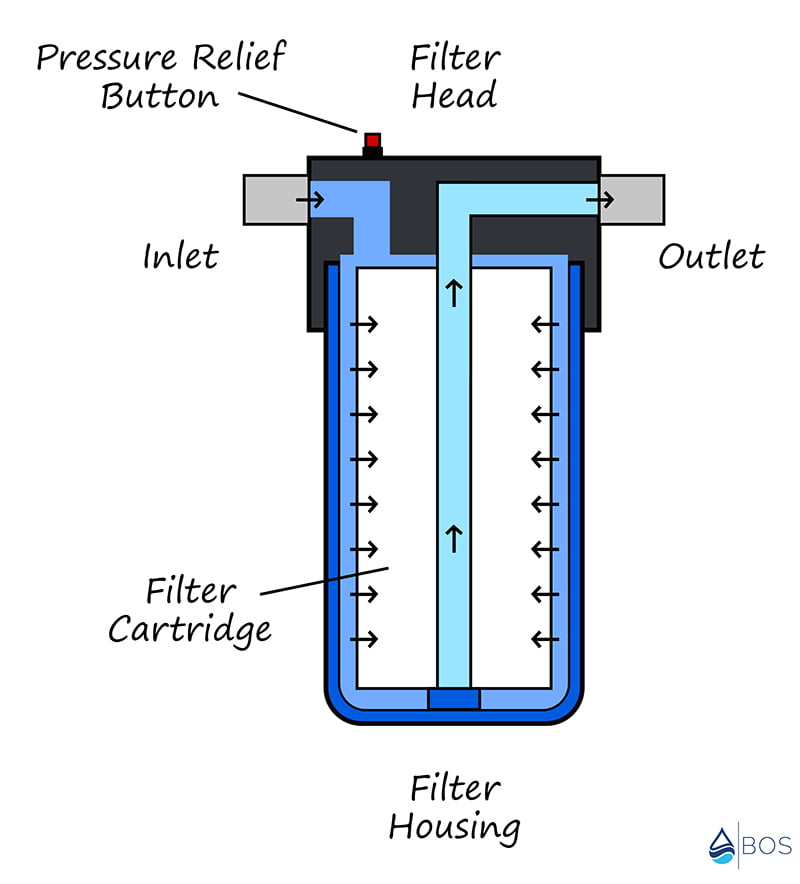Sediment Filter Diagram | All Components at a Glance
Written by: Gene Fitzgerald // Last Updated: Aug 15, 2023
This page may contain affiliate links. If you buy a product or service through such a link we earn a commission at no extra cost to you. Learn more.
A sediment filter traps and removes sediment from your home’s water supply. Stuff like rust flakes from old pipes and stormwater debris leave water unappetizing and discolored. At the same time, sediment build-up damages water-using appliances and clogs up fixtures and valves.
Moreover, sediment prevents water filtration systems like UV purifiers from working effectively.
Whole house sediment filters, therefore, are essential to most water filtration processes, keeping water pure and invigorating.
Key Takeaways
- A sediment filter consists of the following components: Water inlet and outlet, filter housing with head, filter cartridge, and pressure relief button.
What Is a Sediment Filter and How Does It Work?
Sediment filters capture and remove sediment from water, including dust, sand, rust, and silt.
Sediments, generally, vary in size. They can range from small pieces of rock to grains of sand to flakes of rust and come in different textures. For example, some particulates are smooth, while others are rough.
Sediments can make water unfit for domestic use, leaving it discolored and unappetizing. On top of this, contaminants can ruin water-using appliances, like washing machines, heaters, and dishwashers.
Whole house sediment water filters defend against these particles, preventing them from clogging up your plumbing system.
Sediment filters use mechanical filtration and have large pores in order to let clean, uncontaminated water pass, but not solid matter.
Sediment Filter Diagram
This is our cartridge-based sediment filter diagram:
Traditional sediment filters have a filter housing (like the one shown in the above diagram) with a filter cartridge installed inside. Usually, these sediment filtration systems are installed at a home’s main water line or point of entry (POE).
How the different components work:
- The unfiltered water, which comes from either a municipal source or a private well, is connected to the filter inlet.
- Water passes through the inlet into the filter head and then the filter housing surrounding the filter cartridge.
- Internal pressure forces the water to flow through the filter cartridge and into the open central core. Along the way, sediments are being trapped.
- The filtered water flows upwards and out of the outlet connection.
- The water re-enters your plumbing system and is ready for use.
- The pressure relief button can be pressed to release pressure from within the filter housing.
What Does a Sediment Filter Remove?
A sediment filter removes undissolved material like sand, clay, silt, rust flakes, and loose scales from water.
Sediment filters don’t remove dissolved heavy metals, chemicals, salts, etc., neither do they greatly improve the smell or taste of water. That’s why sediment filters are generally used as pre-filters to protect other, more powerful filtration systems from clogging.
What Is a Sediment Filter Used for?
Sediment filters are critical components of most water treatment systems. A sediment filter is paramount when your water is overly dirty. It removes fine particulates from your drinking water and ensures your other filters and water filtration equipment operate efficiently and effectively.
As stated above, sediment filters can protect your plumbing from wear and tear and extend the lifespan of pipes, fixtures, and appliances.
If you have any questions about our sediment filter diagram please don’t hesitate to leave a comment below!
Information provided on BOS is for educational purposes only. The products and services we review may not be right for your individual circumstances.
We adhere to strict editorial guidelines. Rest assured, the opinions expressed have not been provided, reviewed, or otherwise endorsed by our partners – they are unbiased, independent, and the author’s alone. Our licensed experts fact-check all content for accuracy. It is accurate as of the date posted and to the best of our knowledge.


